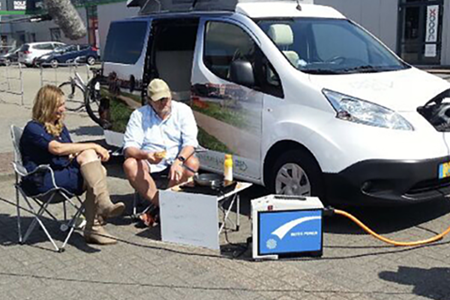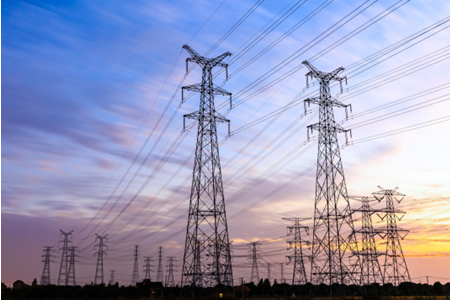With most EVs, electricity goes one way — from the charger, wall outlet or other power source into the battery. There’s an obvious cost to the user for the electricity and, with more than half of all car sales expected to be EVs by the end of the decade, an increasing burden on already overtaxed utility grids.
Bidirectional charging lets you move energy the other way, from the battery to something other than the car’s drivetrain. During an outage, a properly linked EV can send electricity back to a house or business and keep the power on for several days, a process known as vehicle-to-home (V2H) or vehicle-to-building (V2B).
More ambitiously, your EV could also provide power to the network when demand is high — say, during a heat wave when everyone is running their air conditioners — and avoid instability or blackouts. That’s known as vehicle-to-grid (V2G).
Considering that most cars sit parked 95% of the time, it’s a tempting strategy.
But having a car with bidirectional capability is only part of the equation. You also need a special charger that allows energy to flow both ways. We could see that as early as next year: In June, Montreal-based dcbel announced that its r16 Home Energy Station had become the first bidirectional EV charger certified for residential use in the US.
Another bidirectional charger, the Quasar 2 from Wallbox, will be available for the Kia EV9 in the first half of 2024.
Aside from the hardware, you’ll also need an interconnection agreement from your electric company, ensuring that sending power upstream won’t overwhelm the grid.
And if you want to recoup some of your investment with V2G, you’ll need software that directs the system to maintain a level of charge you’re comfortable with while getting you the best price for the energy you sell back. The big player in that area is Fermata Energy, a Charlottesville, Virginia-based company founded in 2010.
“Customers subscribe to our platform and we do all that grid stuff,” says founder David Slutzky. “They don’t have to think about it.”
Fermata has partnered on numerous V2G and V2H pilots across the US. At the Alliance Center, a sustainability-minded coworking space in Denver, a Nissan Leaf is plugged into a Fermata bidirectional charger when it’s not being driven around. The center says Fermata’s demand-peak predictive software is able to save it $300 a month on its electric bill with what’s known as behind-the-meter demand charge management.
In Burrillville, Rhode Island, a Leaf parked at a wastewater treatment plant earned almost $9,000 over two summers, according to Fermata, by discharging electricity back to the grid during peak events.
Right now most V2G setups are small-scale commercial trials. But Slutzky says residential service will soon be ubiquitous.
“This isn’t in the future,” he says. “It’s already happening, really. It’s just that it’s about to scale.”

Bidirectional charging: vehicle to home
The simplest form of bidirectional power is known as vehicle to load, or V2L. With it, you can charge camping equipment, power tools or another electric vehicle (known as V2V). There are more dramatic case uses: Last year, Texas urologist Christopher Yang announced he had completed a vasectomy during an outage by powering his tools with the battery in his Rivian R1T pickup.
You might also hear the term V2X, or vehicle to everything. It’s a bit of a confusing catchall that can be an umbrella term for V2H or V2G or even just managed charging, known as V1G. But others in the auto industry use the abbreviation, in a different context, to mean any kind of communication between the vehicle and another entity, including pedestrians, streetlights or traffic data centers.
Of the various iterations of bidirectional charging, V2H has the broadest support, as human-caused climate change and poorly maintained electrical grids have made outages much more common. There were more than 180 widespread sustained disruptions across the US in 2020, according to a Wall Street Journal review of federal data, up from fewer than two dozen in 2000.
EV battery storage has several benefits over diesel or propane generators, including that, after a disaster, electricity is usually restored faster than other fuel supplies. And traditional generators are loud and cumbersome and spew noxious fumes.
Aside from providing emergency power, V2H can potentially save you money: If you use stored energy to power your home when electricity rates are higher, you can lower your energy bills. And you don’t need an interconnection agreement because you’re not pushing electricity back to the grid.
But using V2H in a blackout only makes sense to a point, says energy analyst Eisler.
“If you’re looking at a situation where the grid is unreliable and might even crash, you have to ask yourself, how long is that crash going to last,” he says. “Are you going to be able to recharge that EV when you need to?”
A similar critique came from Tesla — during the very same investors day press conference in March at which it announced it would add bidirectional functionality. At that event, CEO Elon Musk downplayed the feature as “extremely inconvenient.”
“If you unplug your car, your house goes dark,” he remarked. Of course, V2H would be a direct competitor to the Tesla Powerwall, Musk’s proprietary solar battery.

Bidirectional charging: vehicle to grid
Homeowners in many states can already sell the surplus energy they generate with rooftop solar panels back to the grid. What if the more than 1 million EVs expected to be sold in the US this year could do the same?
According to researchers at the University of Rochester, drivers could save between $120 and $150 a year on their energy bill.
V2G is still in its infancy — power companies are still figuring out how to prepare the grid and how to pay customers who sell them kilowatt hours. But pilot programs are launching around the world: California’s Pacific Gas and Electric, the US’ largest utility, has started enrolling customers in an $11.7 million pilot to figure out how it will ultimately integrate bidirectionality.
Under the plan, residential customers will receive up to $2,500 toward the cost of installing a bidirectional charger and will be paid to discharge electricity back to the grid when there’s an anticipated shortage. Depending on the severity of the need and the capacity people are willing to discharge, participants could make between $10 and $50 per event, PG&E spokesperson Paul Doherty told dot.LA in December,
PG&E has set a goal of supporting 3 million EVs in its service area by 2030, with more than 2 million of them capable of supporting V2G.
Post time: Oct-26-2023

 Portable EV Charger
Portable EV Charger Home EV Wallbox
Home EV Wallbox DC Charger Station
DC Charger Station EV Charging Module
EV Charging Module NACS&CCS1&CCS2
NACS&CCS1&CCS2 EV Accessories
EV Accessories
